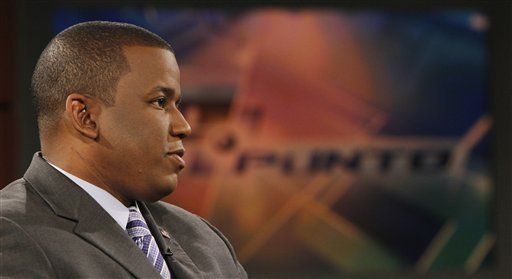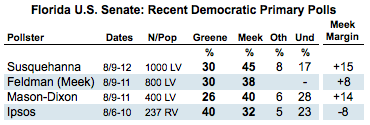
It is not unusual to see highly contradictory poll results in statewide primary elections, but it's rare when we can find easy explanations for those differences. In the case of next week's Democratic primary for Senate in Florida, however, those differences are becoming increasingly clear.
Last week, I shared my hunch that the handful of polls pointing to a close outcome in the race were likely understating the support that Rep. Kendrick Meek would eventually receive in his race against self-funded billionaire Jeff Greene. Three new surveys released last weekend -- by Mason-Dixon Polling and Research, Sunshine State News/VSS and the Meek campaign itself -- all show Meek now leading by margins of between 8 and 15 percentage points. The poll by Ipsos Public Affairs, on the other hand, shows Greene maintaining an 8-point lead (40% to 32%) among a small subsample of 237 Florida Democrats.

The most likely explanation for the difference involves turnout or, more precisely, the challenge of sampling the likely electorate for the Democratic primary. The last two August Democratic primaries held in Florida attracted just over 800,000 of the state's 5.4 million registered Democrats. At that size, the Democratic primary electorate would represent less than 5 percent of Florida's more than 14 million adults. Measuring a target like that is tough for any survey.
To get close, the surveys conducted by Sunshine State News and the Meek campaign used official voter lists to select and dial voters with some prior history of casting ballots in Democratic primaries. The Mason-Dixon survey began with a random-digit sample of all adults in Florida, but then screened for registered voters who say they "vote regularly in state elections" and that they are likely to vote in next weeks' primary.
Ipsos did something very different. Like Mason-Dixon, they began with a random-digit-dial sample of adults and screened for a total sample of 602 registered voters. But to get their sample of Democrats, they screened only on self-reported party identification, selecting the 43% of their full sample of registered voters that identifies or leans Democratic. As such, their sample represents a population of nearly 5 million of Florida's 11 million registered voters. Again, based on past history, the likely turnout is likely to be less than 1 million.
In fairness, Ipsos was doing what a lot of media pollsters do. Their survey was focused mostly on the general election and they appear to have included the primary voter question almost as an afterthought. Nevertheless, the looser likely voter screen they used helps explain why their Democratic primary subgroup is so much friendlier to Greene than the samples drawn by the other pollsters. It probably includes many voters who rarely vote in Democratic primaries and have less knowledge of or affinity for Meek, whose campaign has been touting endorsements from mainline Democrats like Bill Clinton.
On a related issue, Mason-Dixon's president, Brad Coker, kindly shared a cross-tabulation of the results of their poll by the race, education and ideology subgroups I wrote about last week. It turns out that the Mason-Dixon sample includes far more white, college educated liberals (32%) than an earlier survey by Quinnipiac University (14%), though the gap in those numbers may be due to differences in the questions about education or ideology. Nevertheless, the tabulation of results shows a pattern closer to my hunch about where the race seemed headed last week: Meek runs ahead among African-Americans by a margin of 59% to 9% and wins college-educated white liberals by almost two to one (54% to 23%).

Again, as I wrote last week, I'd expect Meeks' share of the African American vote to exceed 80%, so given the margins among other voters, Meek appears headed for a comfortable win next Tuesday.
